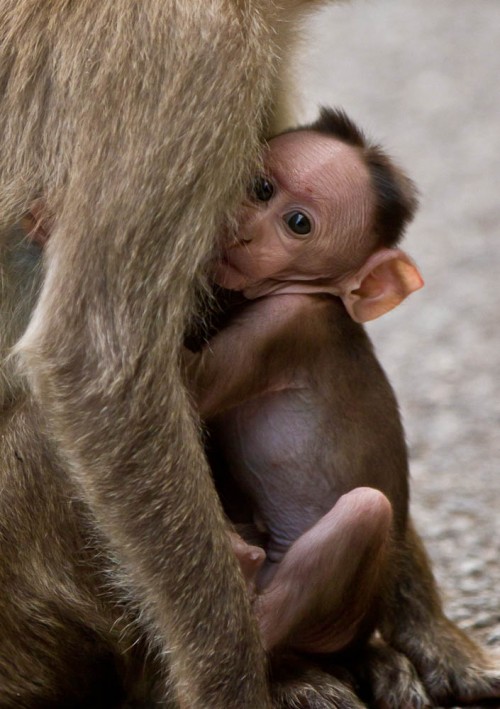
During last summer I had been to Kudremukh national park. Whole park was quite dry. Did not get any great photo opportunity. Returning back in the evening I knew that a family of bonnet macaques (Macaca radiata) near Kadambi water falls. I have been seeing these macaques for quite a few years. They have turned more human friendly due to contact with tourists who feed them. Highway passing though the National park that too connecting quite a few religious places, brings hordes of tourists. Some macaques have resorted to stealing food from open vehicles. This time I saw many young babies with their mothers. Alpha male who usually bosses around the juveniles and others males for food was not to be seen around. Many of these macaques showed injury either due to their fight or road accidents trying grab food from a running vehicles. Few have even been run over by speeding vehicles and have lost body parts in the process.

Evening light that day was very pleasant and quite diffuse. Luckily no tourists were visible on that day. I took my Canon EOS 7D with EF 70-200mm f/2.8L IS II USM to capture these macaques. It is a risky business to approach them as they can be quite aggressive. I was aware that however friendly and cute they look they can jump on you and can attack you if provoked as they have lost the fear of humans. First I saw a young juvenile sitting on top of a sign board expecting me to hand over food. Once he realized that I am not there to feed him he jumped away to nearby tree. Later I approached cautiously towards a mother feeding its baby on the side of the road. She was cautious but cooperative and allowed me to take quite a few pictures without getting annoyed.

I saw another mother baby pair which was sitting on side wall of the bridge. As I approached closer to take the curiously wrinkled face of the baby, mother panicked and started grimacing at me. So I was able to capture both the baby’s innocent face as well as mother’s panic. As I did not want to provoke her further I withdrew. As I backed off she calmed down and gave another pose along with her baby sitting quietly farther away. Tricky part in macaque photography is to get eye contact. Babies and juveniles allow you to look at their eyes. Adults will think looking straight into them is a threat and gets panicky. So you need to be quick while they glance at you to get the photos.

Soon my peace was spoiled by car loads of tourists who landed near me and started teasing and feeding these monkeys with peanuts. Disappointed on lost opportunity to photograph rest of the macaque troop I headed back home. I knew I had quite a few of good pictures but I wanted to take more emotional expressions out of these mother & baby pairs.
The bonnet macaque (Macaca radiata) is a macaque endemic to southern India. Its distribution is limited by the Indian Ocean on three sides and the Godavari and Tapti Rivers along with a related competing species of rhesus macaque in the north. The land use changes in last few decades has resulted in changes in its distribution boundaries with the rhesus macaque, raising concern for its status in the wild.

The bonnet macaque feeds on fruits, nuts, seeds, flowers, invertebrates and cereals. In southern India this macaque exists as commensal to humans, feeding on food given by humans and raiding crops and houses.

Two subspecies of Bonnet Macaques have been identified: Macaca radiata radiata occurs in peninsular India (Andhra Pradesh, Goa, Gujarat, Karnataka, Kerala, Maharashtra and Tamil Nadu). It is found in the major portion of the species’ range south to the Palni Hills and southeast as far as Timbale, inland of Pondicherry.
Macaca radiata diluta occurs in southeastern coastal India (Kerala and Tamil Nadu). It is found from the south tip and southeastern coast of India, north to Kambam in the Western Ghats, at the southwestern foot of the Palni Hills in the center and Pondicherry in the east.

Krishi, there was no mobile coverage in Kadambi I believe ? 🙂
Shiva